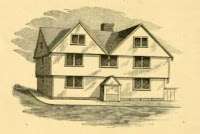Great House (Cape Ann)
Great House in Cape Ann was a seventeenth century structure built by colonists to present-day Gloucester, Massachusetts. It was later disassembled and moved to Salem, Massachusetts, to be the Governor's house.
Origins
When the Thomas Gardner (planter) party of "old planters" came to Cape Ann to establish a fishing colony, they arrived with the necessary provisions to become self-sustaining and to ship seafood product back to England. The area turned out to not allow easy success at the endeavor, but a little-known accomplishment of the small group was to build a house that was the first of its kind in New England. One author wrote: It has been quaintly described by an early writer as "of the model in England first called Tudor, and afterwards the Elizabethan, which was essentially Gothic." It was of two stories with a sharp pitch-roof.[1][lower-alpha 1]

_p037_Roger_Conant's_house%2C_Salem%2C_Mass.jpg)
Information about its origin is scanty, but a lot of the material came with the party. Some material, such as lumber pieces, may have been produced locally. One later observer mentioned that the framing looked to be designed for transportation.[2] When Roger Conant arrived at Cape Ann in 1625, the house was already there.[3] Roger's son, Lot, is thought to have been born in the house.
Moving
In 1628, John Endecott ordered that the house, which was to become known as the Governor's House, was to be disassembled, moved from Cape Ann, and reassembled on what is now Washington Street north of Church Street.[4][5] When Rev. Higginson arrived in Salem, he wrote that "we found a faire house newly built for the Governor" which was remarkable for being two stories high.[6]
Uses of the house
It was in this house that Gov. Winthrop and his party, on their arrival in 1630, partook of their first meal in the new world, dining on venison and beer.[2] Too, according to Gov. Winthrop's diary, the party enjoyed fresh strawberries brought from plantings done at Cape Ann.[7]
The house went through a lot of transitions; a third story was added to in 1792.[2] Tradition has it that some pieces of the old house may have been used for some extant structures.
Pioneer Village replica
There has been a lot written about the house. Unfortunately, sketches were done after the later modifications. George Francis Dow did a detailed study of the house and included a replica in the Pioneer Village built up for the 300th anniversary of Salem's founding.[8]
Notes
- Footnotes
- Image depicts house in mid 1700s, after extension renovation
- Citations
- A walk about Salem. Bacon, E.M. (1898) Historic Pilgrimages in New England Silver, Burdett & Co. (via google.com)
- Letter from Endicott descendant. Endicott, C.M. (1860) "The Old Planters' House" Hist. Coll. of the Essex Institute. Vol II, pg 39 (via google.com)
- Conant 1887, p. 104.
- Goff 2009, p. 24.
- Endicott, Charles M. (1847) Memoir of John Endicott, first governor of the colony of Massachusetts Bay (via archive.org)
- Felt, J.B. (1827) Annals of Salem W.&S. B. Ives
- Jacobson, J. (2009) Massachusetts Bay Connections Genealogical Publishing Co. Pg. 16 (via google.com)
- Dow, G.F. (1935) Everyday Life in the Massachusetts Bay Colony. Heritage Books/reprint (via google.com)
References
- Conant, F.O. (1887). A history and genealogy of the Conant family in England and America. Private Printing.
- Goff, John (2009). Salem's Witch House: A Touchstone to Antiquity. The History Press. ISBN 9781596295193.